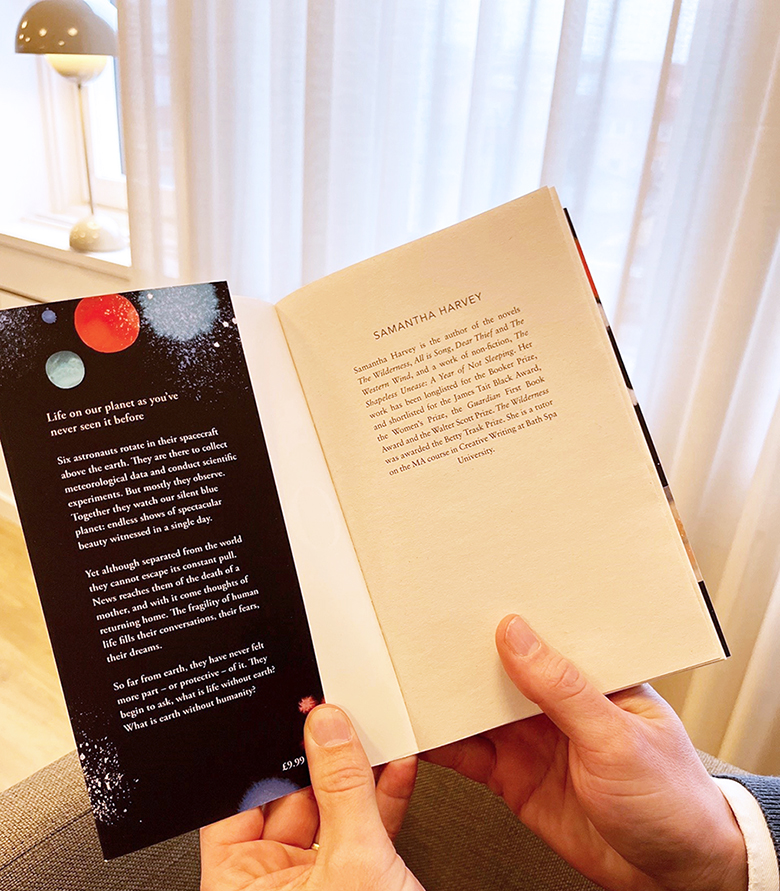This Booker Prize winner was published by Penguin Random House and is printed on Holmen paper.
The Booker Prize, one of the most prestigious literary prizes, is awarded annually to the best novel written in English, as selected by a jury. The prize is £50 000. Orbital is British author Samantha Harvey’s fifth novel and she is the first female winner in five years. At 144 pages, Orbital is not only the second shortest novel to win the competition, but also the best-selling of the nominated entries.
“The novel has been described as a love letter to Earth"
“The novel has been described as a love letter to Earth and I would agree with that. It’s also a detailed account of what it’s like to live in space. After reading it, you see the world from a different perspective, beyond all the wars and conflicts,” says Roger Vian, Commercial Director at Holmen Board and Paper in the UK, who has just finished reading the book.
The 16 chapters describe the daily life of six astronauts on board an international space station. The reader follows them for 24 hours as they travel at tens of thousands of kilometres an hour around the world, for a total of 16 orbits and as many chapters. The story shifts between the spectacular and the ordinary, between distance and intimacy, and is beautifully written.
The unnerving fact of aloneness
Samantha Harvey wrote most of the novel during the COVID lockdown while watching live streams from the International Space Station on her laptop. In an interview in The Guardian, she explains:
“I’ve been looking at images of Earth from space for years. There’s a live camera from the ISS – you can watch the astronauts do spacewalks. Doing multiple orbits of Earth for months online made me want to try to do justice in words to the beauty of the Earth and how I feel about the unnerving fact of its aloneness – could I do justice to that in the way an image can? I put astronauts in it because the novel needed a heartbeat, but they’re just part of the image, not the lens.
Highlighting climate change
Throughout the novel, Samantha Harvey weaves in references to climate change. “Every swirling neon or red algal bloom in the polluted, warming, overfished Atlantic is crafted in large part by the hand of politics and human choices.” Maybe you need to go into space to really understand how the Earth is affected by human progress. As one of the world’s largest book publishers, Penguin Random House has several authors in its stable who offer new perspectives on the planet and address the topic of climate change. The company has published several of David Attenborough’s books, for example, including his latest, A Life on Our Planet.
But the contents of its books are not the only way that Penguin Random House is seeking to contribute to a more sustainable world. The publisher has set a goal of becoming carbon neutral by 2030. Since its own operations are already climate neutral, the 2030 target applies to its global value chain, where Holmen has an important role to play.
Environmentally-conscious choices
Holmen has been a key paper supplier for over a decade, and for some paper grades, Holmen is the sole supplier. The novel Orbital, for example, is printed on Holmen BOOK Bulky 52 gsm.
“One reason why we are the market leader in the book paper market is that our paper has a significantly lower carbon footprint than our competitors’ papers,” explains Roger Vian.
The environment and climate have become an increasingly important issue for European book publishers, as readers become more environmentally aware. Holmen supplies Penguin Random House not just with paper for the book inserts, but also paperboard for the covers.

Holmen’s Incada® is a light-weight and versatile paperboard with low carbon footprint, high stiffness and proven strength, made for consistent and uniform printing and folding results. Incada is manufactured at Holmen’s paperboard mill in Workington, UK, so the short transport distances is an additional advantage.
“Orbital was first launched in paperback, which has certainly contributed to its strong sales,” explains Roger Vian. “Normally the paperback version comes out six months to a year after the hardback.”
Orbital topped the sales charts in the same week that the win was unveiled and publisher Penguin Random House announced it would print 100 000 more copies to meet the market demand.

